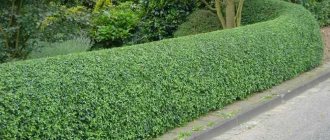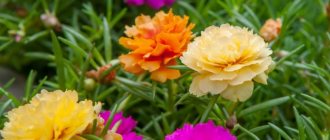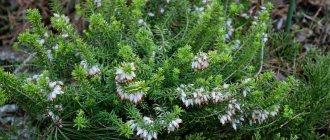Author: Elena N. https://floristics.info/ru/index.php?option=com_contact&view=contact&id=19 Category: Houseplants Published: February 28, 2019Last edits: January 11, 2021
- Propagation by cuttings
- Haworthia striped
The haworthia plant is represented by a number of bizarre and even fancy specimens. Some species resemble magical figurines, others resemble pebbles, others look like stalactites and stalagmites, others seem to be strewn with microscopic pearls, others fascinate with their iridescent colors... While admiring unusual plants, we rarely ask the question: why does it look this way? But Mother Nature had to work on the external appearance of Haworthias in truly extreme conditions. Just imagine: the African desert, the heat reaches 70°C, it rains very rarely, and if it does, most often its drops do not even touch the hot ground - they evaporate on the fly! Only special plants can survive in such conditions. Haworthia is one of them. That is why it is tiny (saves water), covered with tubercles and cilia (catches invaluable moisture), and its colored color (from blue to brown) protects haworthia from sunburn... How to help an exotic plant adapt to our conditions? Let's figure it out together.
Planting and caring for haworthia
- Flowering: decorative foliage plant, succulent.
- Lighting: bright sunlight (southern, eastern or western window), for species with uniformly colored leaves in the summer heat - light partial shade.
- Temperature: normal for residential premises.
- Watering: during the growing season – moderate, after the top layer of the substrate has dried. In winter, if the plant has entered a dormant period - once a month.
- Air humidity: does not matter.
- Feeding: from April to August, once a month with complex fertilizer for cacti in a concentration two times weaker than indicated in the instructions.
- Rest period: not expressed.
- Transplantation: young plants - annually, adults - once every three years, in the spring.
- Reproduction: mainly vegetative - by separation of daughter rosettes.
- Pests: scale insects, mealybugs.
- Diseases: Rot can develop as a result of overwatering or water entering the outlet.
Read more about growing haworthia below.
Haworthia (lat. Haworthia) is a genus of dwarf and miniature herbaceous succulents of the Asphodelaceae subfamily, naturally growing in South Africa. The Haworthia plant received its name in honor of Adrian Haworth, an English botanist who determined the place of this plant in the classification. Haworthia's typically fleshy, dark green leaves form rosettes at soil level, although some species have a short stem. The Haworthia succulent accumulates moisture in the thickenings of its leaves, like in reservoirs, in case of prolonged heat. The edges of the leaves are sometimes smooth, sometimes jagged or covered with long spines. The leaves of some species are covered with white convex tubercles. Plants of this genus often produce many side shoots. Haworthia blooms with small, unattractive white flowers.
Property value
Haworthia exudes not only a certain grace in the home interior, but also some healing benefits. Like many window plants, it produces oxygen and purifies the air of carbon dioxide.
Among other things, it absorbs electromagnetic waves from consumer electronics. The predominant properties give a person energy, stimulate the mental activity of the brain, and improve performance.
The presence of such signs suggests the location of a pot with a succulent on a computer desk, near kitchen electrical equipment.
In an indoor environment, the succulent does not require special care, as it is unpretentious. The main thing is to adhere to some rules.
Features of cultivation
The secret of caring for Haworthia lies solely in following the agrotechnical rules for this genus:
- give it the opportunity to grow on the windowsill of windows facing south, east or west, but shade it from direct sunlight;
- in spring and summer, water moderately; in winter, give it the opportunity to rest at 10-12 ºC, watering once a month;
- Carry out an annual transplant into a wide and shallow pot, ensuring good drainage;
- add 30% fine gravel or brick chips to the substrate, consisting of turf and leaf soil in equal parts.
Watering
It is necessary to water moderately, avoiding stagnation of soil moisture. Carried out once a week. Excess moisture from the pan must be drained immediately after watering.
For this procedure, prepare settled water in advance. Running tap water contains salts that can harm the entire root part. Water from the edge, avoiding liquid getting into the outlet area.
Caring for Haworthia at home
Rules of care
Despite its unusual and attractive appearance, Haworthia is completely unpretentious, and even a novice gardener can cope with growing this beauty, knowing how to care for Haworthia. So, you put it on a sunny windowsill, where it will be light and warm, but in extreme heat, put it in cool partial shade, and best of all, take it out to a shaded balcony or terrace so that the breeze can cool it.
- Alocasia at home
As for air humidity, Haworthia is not very worried about its level - after all, it is a succulent. But ventilation of the room where the flower is located in the summer and even in winter is mandatory.
To water the plant, you will need soft, settled water, which only needs to moisten the top layer of soil in the pot, because the Haworthia cactus needs a very small amount of water: in the summer it is watered as the soil dries out, in the winter, provided that the room temperature is 10-12 ºC - once a month with non-cold water, but if the room is warmer than 18-20 ºC, most likely you will have to water twice as often. Try to pour water under the plant so that moisture does not get into the center of the rosette, because this can cause the haworthia to rot.
If you haven't seen Haworthia bloom, don't worry - its flowers are not very attractive. Therefore, it is better to cut off the flower stalks so that the plant does not waste energy on flowering.
Top dressing
From April to August, it would be a good idea to feed your Haworthia once a month with cactus fertilizer, and the consistency should be twice as thin as indicated on the package. It is better to add fertilizer to the water for irrigation. In the fall, feeding is stopped.
Transfer
Replant the plant as needed when the pot becomes crowded. This usually happens with young plants once a year; adult haworthia is transplanted once every 2-3 years. The pot for Haworthia needs to be small and wide rather than deep, so as not to provoke stagnation of water in the roots.
As a soil mixture, you can use cactus soil purchased at a flower shop, but it is advisable to add a little clay and fine expanded clay to it, which will absorb excess moisture if you accidentally flood the haworthia. Provide good drainage. In general, planting or replanting haworthia is not difficult and does not cause any trouble.
- Begonia evergreen: sowing pelleted seeds in a jar
Reproduction of Haworthia
Propagation by cuttings
If the side rosette has already formed its own roots, it is carefully cut from the mother plant and immediately planted in moist soil. If the cuttings are cut with two or three leaves without roots, you need to powder the cut with ash, then dry the cuttings for several days, then dig them into damp sand for rooting, and when they have roots, transplant them into the ground.
The same is done with leaf cuttings: air-dried for several days, then dropped into loose soil or sand for rooting. There is no need to water the soil until the roots appear, and before that, just lightly sprinkle the surface of the soil with water. And do not cover the container with glass or plastic - the cuttings under the greenhouse will simply rot. It is better to propagate haworthia in the spring during transplantation.
Growing from seeds
Seeds are sown on the surface of damp sand or loose soil and germinated under film or glass at a temperature of 20-25 ºC in a bright place. However, it should be noted that haworthia seeds have low germination rate, and the growing process can take too long, so if you know how to propagate haworthia by vegetative methods, use your knowledge and you will succeed.
Planting
Haworthia mix is not a separate species. This is the name of one of the methods of seating Haworthia. To obtain a highly decorative plant, several varieties are planted in one container.
When planting, you do not need to deepen the root part too much. Favorable soil: clay-turf base, leaf soil, sand.
You definitely need to pay attention to the drainage, which should be located directly at the bottom of the pot.
Kinds
Haworthia striped
A perennial without a trunk, consisting of dense basal rosettes with thick original lanceolate leaves with a white convex stripe on the lower surface, while the upper part of the leaves is smooth and green. The length of the leaves is up to 5 cm, width – a centimeter and a half.
In the photo: Haworthia limifolia variegata
Haworthia drawn
It is similar to the striped one, but not as attractive: instead of white convex stripes, it has only white and green convex dots on its leaves. The lanceolate leaves themselves are directed upward, their length is up to 7 cm, width up to one and a half centimeters.
In the photo: Haworthia maxima
Haworthia sinuous
Sometimes this succulent is called aloe tortuous: the plant has a short stem, up to 15 cm tall, dark green leaves 2.5 cm long, convex below, with small warts.
In the photo: Haworthia truncata
Haworthia adhesive
The plant is 10-20 cm tall, the leaves are small, oval, erect with bent tips, 2.5 cm long and up to 1.5 cm wide, arranged in three rows.
- Tips for caring for homemade geraniums
In the photo: Haworthia marumiana
Haworthia navicularis
Fleshy, shiny, boat-shaped leaves with windows on the surface are collected in a basal rosette, reaching a diameter of 10 cm, and if it has side shoots, then 15-20 cm.
In the photo: Haworthia glauca
Haworthia pearl
A herbaceous succulent perennial with an almost complete absence of a stem, forming a basal rosette of oval-pointed hard leaves 7-8 cm long and 2.5 cm wide. On both sides, the green leaves are covered with pearly white round bumps that look like pearls and give the plant a highly decorative appearance.
In the photo: Haworthia cooperi var. venusta
Haworthia chess
The leaves are thick, triangular in shape, jagged at the edges, collected in small rosettes. On the upper side of the leaves, light streaks form a net; the underside is covered with warts.
Pictured: Haworthia ex Japan
Haworthia Reinwardt
These triangular fleshy leaves, 3.5 cm long and 1-1.5 cm wide, form an elongated rosette. The underside of the leaves is covered with transverse and longitudinal rows of white bumps that stand out brightly against the very dark background of the leaf. The “zebrina” variety of this species has brighter warts, they are larger, and the plant looks very attractive. The erect stem of a young plant bends and falls over time.
Pictured: Haworthia daiginga
Haworthia retusa
Or Haworthia obtuse - has fleshy, hard triangular leaves, bent at the top, up to 5 cm long, covered with transparent windows and light strokes. Leaf color ranges from green to reddish-green or brownish-green. There are variegated and low-chlorophyll forms, and the “Giant” variety is distinguished by large leaves, the tops of which are dissected by veins.
In the photo: Haworthia limifolia striata
Haworthia diseases almost always occur due to violations of agricultural practices, so follow the rules of growing the plant, and you will never have trouble with it.
Photos taken from here











